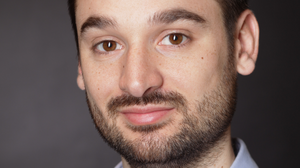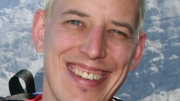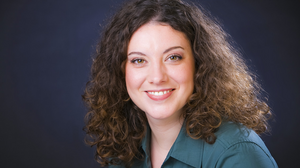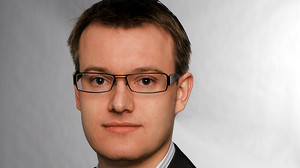Funded researchers: Dr. Alberto Battistel, Dr. Volker Jaedicke, Dr. Daniela Nordzieke & Dr. Sebastian Otten
Dr. Alberto Battistel
Chemistry

Pollution, global warming, nuclear power phase-out, and shortage of fossil fuels push toward a suitable and environmentally friendly energy source. However, renewable sources, like sun and wind, are discontinuous and unpredictable. Now a day, there is a great debate on the energy storage where hydrogen represents one possibility because it can be conveniently generated from electricity. However, its large scale production is still hindered due to a lack of fundamental and technological knowledge and the use of expensive and rare catalysts. In order to design a proper catalyst, a complete understanding of the complex interaction between catalysis and macrokinetic effects is required. The latter is dominated by the dynamics of the formation of gas bubbles at the electrodes, which creates a dynamic triple phase boundary (gas-electrolyte-electrode) interface.
During my Gateway Project I will study this dynamic interface at the École Polytechnique Fédérale de Lausanne (EPFL) in Switzerland. I will join the group of Prof. Hubert Girault which is very active in the field of energy conversion and study of double boundary (liquid-liquid) systems, both essential topic for my project. Thanks to this fellowship I can develop my own independent research project in a prestigious institute where I can get in contact with new researchers and implement my scientific and cultural profile.
Dr. Volker Jaedicke
Electrical Engineering

During my Gateway Fellowship I will stay in Prof. Laura Wallers group at the University of California in Berkeley. During this time I will further develop a new kind of microscope. For this purpose I will use concepts known from computational optics and coded illumination. I will use these concepts to enhance the resolution and calculate three dimensional images using a modified standard microscope. In coded illumination the sample is illuminated from different directions and a stack of images is recorded.
Computational optics is a concept where the computer is seen as an integral part of the imaging system. Additionally I will use the concept of the phase microscope. Light can be characterized by its phase and amplitude. In a standard light microscope only the amplitude attenuation due to the sample is displayed. In contrast the phase delay can carry additional information about the sample. This information can be used to improve the contrast of the images. For three dimensional imaging I will replace the light source of a standard microscope by a LED array. The combination of coded illumination due to the LED array and the phase information will enable to calculate three dimensional tomographic phase images. Because only the light source of the microscope is replaced and the images are calculated using a computer this concept can also be transferred to smart phone based microscopes. These microscopes are cost effective and therefore useful for applications in remote settings (e.g. in developing countries).
Dr. Daniela Nordzieke
Biology

How does a pathogen specifically detect its host? What molecules serve thereby as signals? And how are these signals transformed into a specific behavioral change of the pathogen? Unraveling these fundamental questions is the aim of my Gateway Fellowship performed at the group of Prof. A. Di Pietro at the University of Córdoba in the South of Spain.
The pathogen of interest is the worldwide living soil-borne fungus, Fusarium oxysporum f. sp. Lycopersici, which infects tomato plants by invasion of the roots, resulting in vascular wilt disease and enormous crop losses every year. To study the key step of infection - the host recognition - several methods of investigations were recently established by the group in Córdoba. Using these methods I will draft a first model of signals and output processes governing this infection process during research stay. Besides the practical work in the lab and the establishment of an own research topic, this stay will also enable me to work within the Marie Curie funded FUNGIBRAIN project and thus to work with several top researchers from all over Europe. This network will give me an excellent starting point to perform independent research in cooperation with other European groups in the future.
Dr. Sebastian Otten
Economy

Prenatal and early-life conditions affect health not only at birth and during infancy, but also throughout life. The identification of the causal relationship between these factors, however, is difficult. In my Gateway Fellowship project, hosted by Prof. Till von Wachter at the University of California, Los Angeles (UCLA), we examine the long-run effects of malnutrition and mental stress on the physical and mental health of older individuals in Germany using World War II (WWII) as a natural experiment.
The traumatization by WWII and the exposure to the German famine of 1945–1948 present exceptional opportunities to evaluate the consequences of mental stress and prenatal malnutrition. In our analysis we combine data on regional destruction in Germany caused by the Allied Air Forces bombing with administrative data from a large German sickness fund covering about 2 million individuals born between 1920 and 1955. The data provides information on medical diagnoses of both mental (e.g., depression) and physical diseases (e.g., cardiovascular diseases, diabetes) as well as on the prescription of several types of drugs. The causal effects of mental stress and prenatal malnutrition during early life are identified by using (i) geographic variation in the intensity of WWII destruction as an exogenous measure of traumatization and (ii) variation in birth cohorts to capture the effect of malnutrition during the famine. As such, our project is the first study to use administrative health data to estimate the long-term effects of plausibly exogenous events on objective measures of health for a representative, large group of individuals.
- Forschungsbezogene Kompetenzen: Workshops & Veranstaltungen
- Karrierevorbereitung: Workshops & Veranstaltungen
- Forschungsmanagement Skills: Workshops & Veranstaltungen
- Liste aller Workshops & Veranstaltungen
- Förderprogramme zur Internationalisierung
- Beratung & Ombudsperson
- Promovierenden-Datenbank
- Welcome Hour
- Newsletter


